Fukushima Prefecture has been conducting “Prefecture Health Management Survey” including estimation of external radiation exposure dose, thyroid examination, basic medical examination, psychological questionnaire, survey of pregnant women and women with babies.
The result of the initial round of preliminary thyroid examination of 38,114 children, out of approximately 360,000 eligible children, was released in the sixth report of Fukushima Prefecture Health Management Survey on April 26, 2012.
http://www.pref.fukushima.jp/imu/kenkoukanri/240426shiryou.pdf
Further analysis of the same result from these 38,114 children was published in the seventh report of Fukushima Prefecture Health Management Survey on June 12, 2012.
http://www.pref.fukushima.jp/imu/kenkoukanri/240612shiryou.pdf
Please refer to the previous article in regards to the letter from Shunichi Yamashita to Japan Thyroid Association members, dated January 16, 2012, asking them to adhere to the guidelines set by Fukushima Medical University in managing thyroid abnormalities.
http://fukushimavoice-eng.blogspot.com/2012/05/fukushima-childrens-thyroid-examination.html
Below is the straight translation of the thyroid examination section of the Fukushima Prefecture Health Management Survey.
******************************************************************************************************
The Sixth Report of Fukushima Prefecture Health Management Survey
April 26, 2012
Implementation status for “thyroid examination” in Prefecture Health Management Survey
1. Purpose of survey
The health effects from Tokyo Electric Company Fukushima Dai-ichi Nuclear Power Plant accident due to East Japan Great Earthquake are considered to be extremely unlikely, considering the current radiation levels. However, Chernobyl nuclear accident revealed pediatric thyroid cancer from internal radiation exposure due to radioactive iodine.
Thus, children’s health is to be watched on a long-term basis. Thyroid examination was implemented in October 2011 to assess the current thyroid conditions to track children’s lifetime health and to relieve children and parents of worries.
2. Subjects
All Fukushima residents (including those who evacuated out of Fukushima) who were ages 0 to 18 on March 11, 2011. Approximately 360,000 residents. In concrete terms it covers all Fukushima Prefecture residents (including those who evacuated out of Fukushima) who were born between April 2, 1992 and April 1, 2011.
3. Implementation plan details
(1) Method:
If thyroid mass (nodular lesion) is detected upon thyroid ultrasound examination, secondary examination (more detailed ultrasound examination, blood test, urine test, and biopsy if needed) at Fukushima Medical University Hospital.
(2) Implementation schedule:
Preliminary examination (examination for assessment of current status) will be performed on all eligible residents from October 2011 to March 2014.
In addition, after April 2014, standard examination will be done every two years up to age 20 and every five years after age 20, watching over the health of residents for the remainder of their lives.
Also the target group will be expanded to include those who were born before April 1, 2012.
4. Fiscal Year 2011 Implementation status
(1) Subjects:
47,766 residents from evacuated areas specified by the government, including Tamura-city, Minamisoma-city, Date-city, Kawamata-machi, Hirono-machi, Naraha-machi, Tomioka-machi, Kawauchi-mura, Okuma-machi, Futaba-machi, Namie-machi, Katsurao-mura, and Iitate-mura.
(2) Implementation status:
(3) Major efforts made to implement examination:
In fiscal year 2011, the following efforts were made in implementing the examination. They were intended to take into consideration the convenience of examination subjects and structure more effective and efficient examination system, so that as many residents could receive examination as possible.
5. Fiscal year 2012 implementation plan (proposal)
In fiscal year 2012, examination will be implemented in a planned, effective and efficient manner for subjects living in areas other than the government-specified evacuation areas. In addition, medical facilities outside Fukushima Prefecture will be certified to provide thyroid examination so that those who evacuated out of Fukushima will be able to receive the examination in relocated areas.
Summary of examination schedule and target groups:
First examination:
Second examination and beyond:
All-prefecture standard examination
Date: April 2014 -
*Every two years up to age 20 and every 5 years after age 20.
Fiscal Year 2011 Thyroid Examination Implementation Status
(as of the end of March, 2012)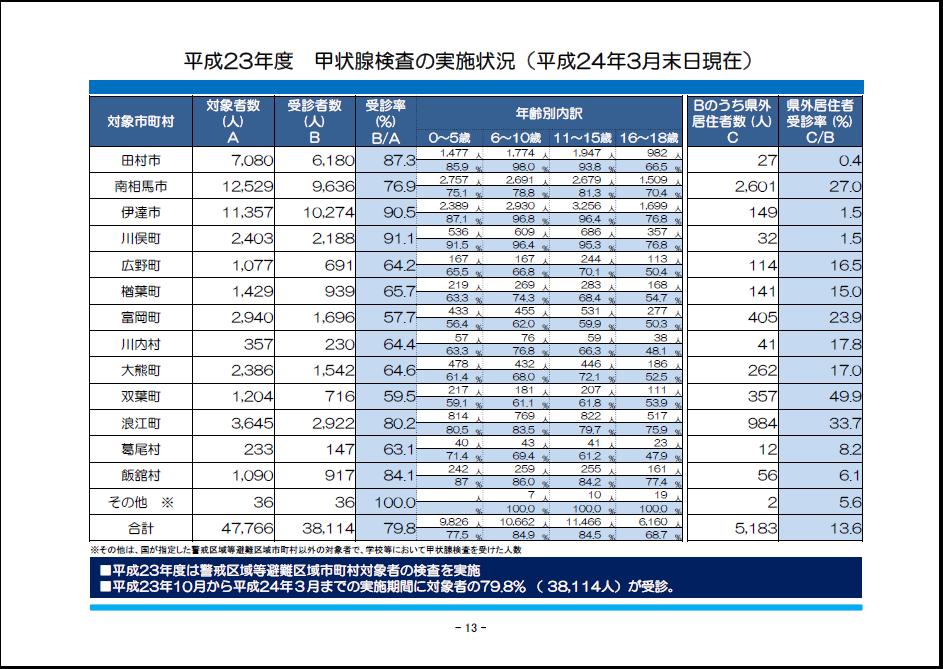
Captions for the table from left to right:
Town/village name, number of subjects (A), number of examined residents (B), % examined (B/A), breakdown by age group, number of examined residents living outside Fukushima (C), % out-of-prefecture residents examined (C/B).
Town/Village names from top to bottom: Tamura-city, Minamisoma-city, Date-city, Kawamata-machi, Hirono-machi, Naraha-machi, Tomioka-machi, Kawauchi-mura, Okuma-machi, Futaba-machi, Namie-machi, Katsurao-mura, Iitate-mura.
Fiscal Year 2011 Thyroid Examination Summary (as of the end of March, 2012)

Total Number of children tested: 38,114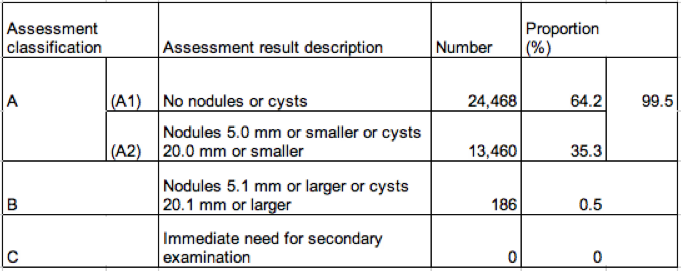
Explanation for assessment results:
Summary

Some cases had both nodules and cysts.
***************************************************************************************************
The Seventh Report of Fukushima Prefecture Health Management Survey
June 12, 2012
Fiscal Year 2012 Thyroid Examination Implementation Status (as of June 8, 2012)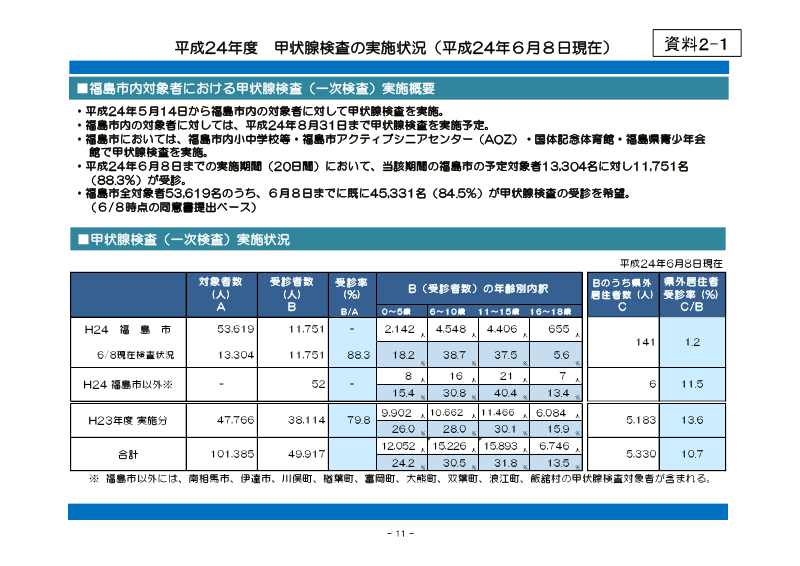 For original document, please refer to this link so that you may zoom in.
For original document, please refer to this link so that you may zoom in.
https://docs.google.com/file/d/0B68f83tqq7Qud05vOWNGaXpkUU0/edit
(Page 11 of the report, which is page 14 of the actual document.)
Thyroid examination (primary examination) implementation summary for subjects in Fukushima-city
Primary thyroid examination implementation status (bottom table)
Captions from left to right: number of subjects (A), number of examined residents (B), % examined (B/A), breakdown by age group for B, out-of-prefecture residents in B (C), % of out-of-prefecture residents examined (C/B)
Captions from top to bottom: H24 (Heisei 24 = 2012) Fukushima-city, examination status as of June 8, H24 (2012) outside Fukushima-city, examination implemented in H23 (Fiscal year 2011)
*The”outside Fukushima-city” category includes subjects from Minamisoma-city, Date-city, Kawamata-machi, Naraha-machi, Tomioka-machi, Okuma-machi, Futaba-machi, Namie-machi and Iitate-mura.
**************************************************************************************************
Fiscal Year 2011 Thyroid Examination Summary (as of the end of March, 2012)
For original document, please refer to this link so that you may zoom in.
https://docs.google.com/file/d/0B68f83tqq7Qud05vOWNGaXpkUU0/edit
(Page 12 of the report, which is page 15 of the actual document.)
Note that the first table in this summary is basically the same as one from the 6th report except the number with cysts smaller than 20.0 mm is 13,383 instead of 13,379 for some reason.
Subsequent tables and graphs show more detailed information of the data reported in the 6th report, such as the breakdown by sex, age, and size of nodules and cysts.
Total Number of children tested: 38,114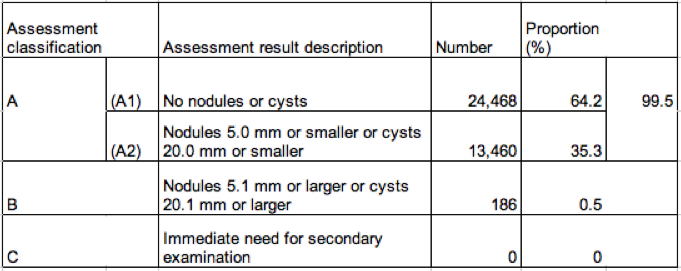
Explanation for assessment results:
Summary
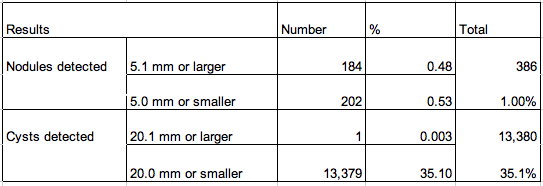
Some cases had both nodules and cysts.
***************************************************************************************************
Fiscal year 2011 thyroid examination summary (as of the end of March 2012)
For original document, please refer to this link so that you may zoom in.
https://docs.google.com/file/d/0B68f83tqq7Qud05vOWNGaXpkUU0/edit
(Page 13 of the report, which is page 16 of the actual document.)
1. Assessment status
Captions from left to right: age groups, A1, A2, B, C, Total (Each assessment result subdivided into male/female/total.)
Captions from top to bottom on left: age groups, 0-5 years, 6-10 years, 11-15 years, over 16 years
2. Breakdown by sex and age groups
Left bar graph: male
Right bar graph: female
blue=A1, red=A2, green=B, purple=C
Following data shows the thyroid examination subjects who had nodules in the fiscal year 2011 examination.
For original document, please refer to this link so that you may zoom in.
https://docs.google.com/file/d/0B68f83tqq7Qud05vOWNGaXpkUU0/edit
(Page 14 of the report, which is page 17 of the actual document.)
The table on bottom left shows breakdown by size of nodules and sex.
Left column shows size.
Of 38,114 examined, 37,729 (19,036 boys and 18,693 girls) had no nodules.
201 had nodules graded A2, smaller than 5.0 mm.
184 had nodules graded B, larger than 5.0 mm.
The graph on right shows further breakdown of size of nodule at 1 mm increments.
Girls shown in red line and boys in green.
Following data shows the thyroid examination subjects who had cysts in the fiscal year 2011 examination.
For original document, please refer to this link so that you may zoom in.
https://docs.google.com/file/d/0B68f83tqq7Qud05vOWNGaXpkUU0/edit
(Page 15 of the report, which is page 18 of the actual document.)
The table on bottom left shows breakdown by size of cysts and sex.
Left column shows size.
Of 38,114 examined, 24,730 (12,890 boys and 11,840 girls) had no cysts..
12,414 had cysts smaller than 5.0 mm.
969 had cysts graded A2, smaller than 20.0 mm.
1 had cysts graded B, larger than 20.0 mm.
The graph on right shows further breakdown of size of cysts at 1 mm increments.
Download :Thyroid Examination by Fukushima Prefecture
https://docs.google.com/open?id=0B68f83tqq7QuZUdCZXhTLVl2dEE
The result of the initial round of preliminary thyroid examination of 38,114 children, out of approximately 360,000 eligible children, was released in the sixth report of Fukushima Prefecture Health Management Survey on April 26, 2012.
http://www.pref.fukushima.jp/imu/kenkoukanri/240426shiryou.pdf
Further analysis of the same result from these 38,114 children was published in the seventh report of Fukushima Prefecture Health Management Survey on June 12, 2012.
http://www.pref.fukushima.jp/imu/kenkoukanri/240612shiryou.pdf
Please refer to the previous article in regards to the letter from Shunichi Yamashita to Japan Thyroid Association members, dated January 16, 2012, asking them to adhere to the guidelines set by Fukushima Medical University in managing thyroid abnormalities.
http://fukushimavoice-eng.blogspot.com/2012/05/fukushima-childrens-thyroid-examination.html
Below is the straight translation of the thyroid examination section of the Fukushima Prefecture Health Management Survey.
******************************************************************************************************
The Sixth Report of Fukushima Prefecture Health Management Survey
April 26, 2012
Implementation status for “thyroid examination” in Prefecture Health Management Survey
1. Purpose of survey
The health effects from Tokyo Electric Company Fukushima Dai-ichi Nuclear Power Plant accident due to East Japan Great Earthquake are considered to be extremely unlikely, considering the current radiation levels. However, Chernobyl nuclear accident revealed pediatric thyroid cancer from internal radiation exposure due to radioactive iodine.
Thus, children’s health is to be watched on a long-term basis. Thyroid examination was implemented in October 2011 to assess the current thyroid conditions to track children’s lifetime health and to relieve children and parents of worries.
2. Subjects
All Fukushima residents (including those who evacuated out of Fukushima) who were ages 0 to 18 on March 11, 2011. Approximately 360,000 residents. In concrete terms it covers all Fukushima Prefecture residents (including those who evacuated out of Fukushima) who were born between April 2, 1992 and April 1, 2011.
3. Implementation plan details
(1) Method:
If thyroid mass (nodular lesion) is detected upon thyroid ultrasound examination, secondary examination (more detailed ultrasound examination, blood test, urine test, and biopsy if needed) at Fukushima Medical University Hospital.
(2) Implementation schedule:
Preliminary examination (examination for assessment of current status) will be performed on all eligible residents from October 2011 to March 2014.
In addition, after April 2014, standard examination will be done every two years up to age 20 and every five years after age 20, watching over the health of residents for the remainder of their lives.
Also the target group will be expanded to include those who were born before April 1, 2012.
4. Fiscal Year 2011 Implementation status
(1) Subjects:
47,766 residents from evacuated areas specified by the government, including Tamura-city, Minamisoma-city, Date-city, Kawamata-machi, Hirono-machi, Naraha-machi, Tomioka-machi, Kawauchi-mura, Okuma-machi, Futaba-machi, Namie-machi, Katsurao-mura, and Iitate-mura.
(2) Implementation status:
- Primary examination: Examination was started at Fukushima Medical University Hospital on October 9, 2011. Examination was then performed off-site at public facilities in Kawamata-machi, Minamisoma-city, and other places. By the end of fiscal year 2011 (the end of March 2011), 38,114 residents (79.8% of eligible residents) were examined.
- Reporting of primary examination result: Assessment Committee established within Fukushima Medical University evaluated and analyzed the ultrasound images. As for those who received examination within fiscal year 2011 have already received the results by mail.
- Secondary examination: For those requiring secondary examination, Fukushima Medical University officially notified them of the date, time and place of the examination. Specialists have been conducting secondary examination since March 2012 at Fukushima Medical University Hospital. In regards to the result of the secondary examination, subjects were asked to come back to the hospital one to two weeks later to have the specialists explain the result in person. By this time (April 12, 2012), 14 have undergone secondary examination and 6 have received the result.
(3) Major efforts made to implement examination:
In fiscal year 2011, the following efforts were made in implementing the examination. They were intended to take into consideration the convenience of examination subjects and structure more effective and efficient examination system, so that as many residents could receive examination as possible.
[1] Consideration in securing examination opportunities for subjects
- For those not examined, effort was made to secure examination opportunities as much as possible by re-sending new examination schedule.
- Examination was performed at locations (16 locations in Fukushima Prefecture not including schools) as close to evacuation locations as possible.
- For school-age children and older students, examination was performed at their schools.
- At the examination site, a fast examination process was made possible by designing an integrated system including reception, actual examination (including explanation) and saving of ultrasound images.
- Implementation of examination was made possible for the age 0 to 5 group, which had been anticipated to be difficult examination subjects.
[2] Securing the quality of the examination
- Support of thyroid specialists in and outside Fukushima Prefecture was obtained by widely publicizing the thyroid examination and asking for cooperation through Japan Thyroid Association, Japan Association of Endocrine Surgeons, Japan Society of Thyroid Surgery, The Japanese Society for Pediatric Endocrinology, The Japan Society of Ultrasonics in Medicine, Japanese Society of Sonographers, and The Japan Association of Breast and Thyroid Sonology.
- Quality of examination over a certain standard was secured by direct involvement of thyroid specialists in the examination. Also an effort was made to secure qualified personnel through direct instruction by the said specialists.
*As many as 61 specialists outside of Fukushima Medical University assisted with examination multiple times during the fiscal year 2011.
[3] Establishing the base for thyroid examination within Fukushima Prefecture
- In order to solidify the thyroid examination system within Fukushima Prefecture, a thyroid examination workshop was held in Fukushima-city on March 4 for physicians and technicians.
5. Fiscal year 2012 implementation plan (proposal)
In fiscal year 2012, examination will be implemented in a planned, effective and efficient manner for subjects living in areas other than the government-specified evacuation areas. In addition, medical facilities outside Fukushima Prefecture will be certified to provide thyroid examination so that those who evacuated out of Fukushima will be able to receive the examination in relocated areas.
Summary of examination schedule and target groups:
First examination:
Initial preliminary examination
Date: October 2011 to November 2011
Location: Fukushima Medical University
Target group: Part of subjects from planned evacuation areas (Yamakiya region of Kawamata-machi, Namie-machi and Iitate-mura)
All-prefecture preliminary examination
Date: November 2011 to March 2014
Location: Facilities such as health centers, community centers and schools (Performed by physicians from Fukushima Medical University and also with cooperation of physicians in and outside Fukushima Prefecture.)
Target group: Unexamined residents from planned evacuation areas and all other subjects.
Second examination and beyond:
All-prefecture standard examination
Date: April 2014 -
Location: Examination centers in Fukushima Prefecture and medical facilities outside Fukushima Prefecture.
Target group: All subjects..*Every two years up to age 20 and every 5 years after age 20.
Fiscal Year 2011 Thyroid Examination Implementation Status
(as of the end of March, 2012)
- In the fiscal year 2011, examination was done in residents of evacuated areas.
- In the examination period from October 2011 through March 2012, 79.8% (38,114) of eligible residents had thyroid examinations.
Captions for the table from left to right:
Town/village name, number of subjects (A), number of examined residents (B), % examined (B/A), breakdown by age group, number of examined residents living outside Fukushima (C), % out-of-prefecture residents examined (C/B).
Town/Village names from top to bottom: Tamura-city, Minamisoma-city, Date-city, Kawamata-machi, Hirono-machi, Naraha-machi, Tomioka-machi, Kawauchi-mura, Okuma-machi, Futaba-machi, Namie-machi, Katsurao-mura, Iitate-mura.
Fiscal Year 2011 Thyroid Examination Summary (as of the end of March, 2012)
Total Number of children tested: 38,114
Explanation for assessment results:
- A1 and A2 will be followed until the next examination (after 2014)
- B and C will have secondary examination (They will be notified of date and place.)
Summary
Some cases had both nodules and cysts.
***************************************************************************************************
The Seventh Report of Fukushima Prefecture Health Management Survey
June 12, 2012
Fiscal Year 2012 Thyroid Examination Implementation Status (as of June 8, 2012)
https://docs.google.com/file/d/0B68f83tqq7Qud05vOWNGaXpkUU0/edit
(Page 11 of the report, which is page 14 of the actual document.)
Thyroid examination (primary examination) implementation summary for subjects in Fukushima-city
- Beginning May 14, 2012, subjects in Fukushima-city began receiving thyroid examination.
- Subjects in Fukushima-city will have thyroid examination until August 31, 2012.
- In Fukushima-city, thyroid examinations will be held at elementary and junior high schools, Fukushima-city Active Senior Center (AOZ), National Sports Festival of Japan Memorial Gymnasium, and Fukushima Youth Hall.
- In the 20-day implementation period up to June 8, 2012, 11,751 out of expected 13,304 actually received the examination.
- Of 53,619 subjects in Fukushima-city, 45,331 (84.5%) already expressed interest in receiving thyroid examination by June 8. (Based on the consent form submission as of June 8)
Primary thyroid examination implementation status (bottom table)
Captions from left to right: number of subjects (A), number of examined residents (B), % examined (B/A), breakdown by age group for B, out-of-prefecture residents in B (C), % of out-of-prefecture residents examined (C/B)
Captions from top to bottom: H24 (Heisei 24 = 2012) Fukushima-city, examination status as of June 8, H24 (2012) outside Fukushima-city, examination implemented in H23 (Fiscal year 2011)
*The”outside Fukushima-city” category includes subjects from Minamisoma-city, Date-city, Kawamata-machi, Naraha-machi, Tomioka-machi, Okuma-machi, Futaba-machi, Namie-machi and Iitate-mura.
**************************************************************************************************
Fiscal Year 2011 Thyroid Examination Summary (as of the end of March, 2012)
For original document, please refer to this link so that you may zoom in.
https://docs.google.com/file/d/0B68f83tqq7Qud05vOWNGaXpkUU0/edit
(Page 12 of the report, which is page 15 of the actual document.)
Note that the first table in this summary is basically the same as one from the 6th report except the number with cysts smaller than 20.0 mm is 13,383 instead of 13,379 for some reason.
Subsequent tables and graphs show more detailed information of the data reported in the 6th report, such as the breakdown by sex, age, and size of nodules and cysts.
Total Number of children tested: 38,114
Explanation for assessment results:
- A1 and A2 will be followed until the next examination (after 2014)
- B and C will have secondary examination (They will be notified of date and place.)
Summary
Some cases had both nodules and cysts.
***************************************************************************************************
Fiscal year 2011 thyroid examination summary (as of the end of March 2012)
For original document, please refer to this link so that you may zoom in.
https://docs.google.com/file/d/0B68f83tqq7Qud05vOWNGaXpkUU0/edit
(Page 13 of the report, which is page 16 of the actual document.)
1. Assessment status
Captions from left to right: age groups, A1, A2, B, C, Total (Each assessment result subdivided into male/female/total.)
Captions from top to bottom on left: age groups, 0-5 years, 6-10 years, 11-15 years, over 16 years
2. Breakdown by sex and age groups
Left bar graph: male
Right bar graph: female
blue=A1, red=A2, green=B, purple=C
Following data shows the thyroid examination subjects who had nodules in the fiscal year 2011 examination.
For original document, please refer to this link so that you may zoom in.
https://docs.google.com/file/d/0B68f83tqq7Qud05vOWNGaXpkUU0/edit
(Page 14 of the report, which is page 17 of the actual document.)
The table on bottom left shows breakdown by size of nodules and sex.
Left column shows size.
Of 38,114 examined, 37,729 (19,036 boys and 18,693 girls) had no nodules.
201 had nodules graded A2, smaller than 5.0 mm.
184 had nodules graded B, larger than 5.0 mm.
The graph on right shows further breakdown of size of nodule at 1 mm increments.
Girls shown in red line and boys in green.
Following data shows the thyroid examination subjects who had cysts in the fiscal year 2011 examination.
For original document, please refer to this link so that you may zoom in.
https://docs.google.com/file/d/0B68f83tqq7Qud05vOWNGaXpkUU0/edit
(Page 15 of the report, which is page 18 of the actual document.)
The table on bottom left shows breakdown by size of cysts and sex.
Left column shows size.
Of 38,114 examined, 24,730 (12,890 boys and 11,840 girls) had no cysts..
12,414 had cysts smaller than 5.0 mm.
969 had cysts graded A2, smaller than 20.0 mm.
1 had cysts graded B, larger than 20.0 mm.
The graph on right shows further breakdown of size of cysts at 1 mm increments.
Girls shown in red line and boys in green.
Download :Thyroid Examination by Fukushima Prefecture
https://docs.google.com/open?id=0B68f83tqq7QuZUdCZXhTLVl2dEE

What percentage of children normally have nodules or cysts on their thyroid gland?
ReplyDeletemedjet coupons
ReplyDeleteI just read through the entire article of yours and it was quite good. This is a great article thanks for sharing this informative information
Here is some context for these results:
ReplyDeletehttp://fukushimavoice-eng.blogspot.com/2012/07/position-statement-what-is-currently.html